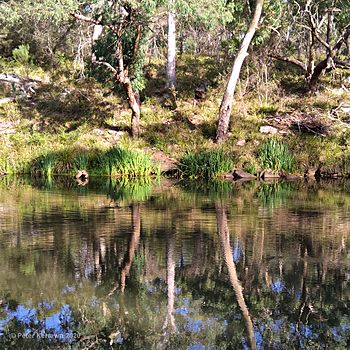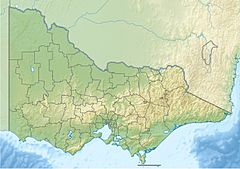Berrima River facts for kids
Quick facts for kids Berrima |
|
|---|---|

Scene along the riverbank walk at Berrima
|
|
| Other name(s) | Suggan Buggan, Toonginbooka, Oonginbooka |
| Country | Australia |
| State | New South Wales, Victoria |
| Region | Australian Alps (IBRA), Snowy Mountains, Victorian Alps |
| Local government areas | Snowy Monaro Regional Council, Shire of East Gippsland |
| Physical characteristics | |
| Main source | Berrima Range, Great Dividing Range Snowy Mountains, New South Wales 1,030 m (3,380 ft) 36°48′4″S 148°14′42″E / 36.80111°S 148.24500°E |
| River mouth | confluence with Freestone Creek to form the Suggan Buggan River Alpine National Park, Victoria 695 m (2,280 ft) 36°51′54″S 148°14′7″E / 36.86500°S 148.23528°E |
| Length | 8 km (5.0 mi) |
| Basin features | |
| River system | Snowy River catchment |
| National park | Alpine NP |
The Berrima River is a small river in the Australian Alps. It flows through two Australian states: New South Wales and Victoria. Sometimes, in New South Wales, people call it the Berrima Creek.
This river is a perennial stream, which means it flows all year round. It's part of the larger Snowy River system.
Contents
Where Does the Berrima River Flow?
The Berrima River starts high up in the mountains. Its source is near the Berrima Range in the Snowy Mountains. This area is a wild and remote part of New South Wales.
River's Journey and End Point
The river flows mostly south. It travels about 8 kilometers (5 miles). Along its journey, the river drops 336 meters (1,102 feet) in height.
The Berrima River eventually joins with another stream called Freestone Creek. When two rivers meet, it's called a confluence. After they meet, they form a new river called the Suggan Buggan River. This meeting point is in Victoria, inside the beautiful Alpine National Park.
What Does "Berrima" Mean?
The name Berrima comes from the Aboriginal language. It means "to the south". This tells us something about the river's direction or location.
Who Lived Here First?
The land around the Berrima River has a long history. The original owners and caretakers of this land are the Aboriginal peoples. Specifically, the Bidhawal and Nindi-Ngudjam Ngarigu Monero peoples are the traditional custodians of this area. They have lived here for thousands of years.


